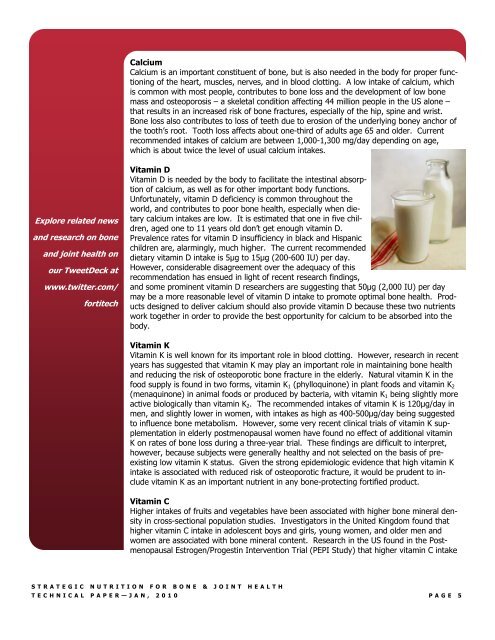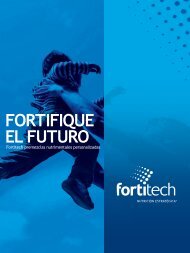Strategic Nutrition for Bone and Joint Health - Fortitech
Strategic Nutrition for Bone and Joint Health - Fortitech
Strategic Nutrition for Bone and Joint Health - Fortitech
You also want an ePaper? Increase the reach of your titles
YUMPU automatically turns print PDFs into web optimized ePapers that Google loves.
PAGE 2CalciumCalcium is an important constituent of bone, but is also needed in the body <strong>for</strong> proper functioningof the heart, muscles, nerves, <strong>and</strong> in blood clotting. A low intake of calcium, whichis common with most people, contributes to bone loss <strong>and</strong> the development of low bonemass <strong>and</strong> osteoporosis – a skeletal condition affecting 44 million people in the US alone –that results in an increased risk of bone fractures, especially of the hip, spine <strong>and</strong> wrist.<strong>Bone</strong> loss also contributes to loss of teeth due to erosion of the underlying boney anchor ofthe tooth’s root. Tooth loss affects about one-third of adults age 65 <strong>and</strong> older. Currentrecommended intakes of calcium are between 1,000-1,300 mg/day depending on age,which is about twice the level of usual calcium intakes.Explore related news<strong>and</strong> research on bone<strong>and</strong> joint health onour TweetDeck atwww.twitter.com/<strong>for</strong>titechVitamin DVitamin D is needed by the body to facilitate the intestinal absorptionof calcium, as well as <strong>for</strong> other important body functions.Un<strong>for</strong>tunately, vitamin D deficiency is common throughout theworld, <strong>and</strong> contributes to poor bone health, especially when dietarycalcium intakes are low. It is estimated that one in five children,aged one to 11 years old don’t get enough vitamin D.Prevalence rates <strong>for</strong> vitamin D insufficiency in black <strong>and</strong> Hispanicchildren are, alarmingly, much higher. The current recommendeddietary vitamin D intake is 5µg to 15µg (200-600 IU) per day.However, considerable disagreement over the adequacy of thisrecommendation has ensued in light of recent research findings,<strong>and</strong> some prominent vitamin D researchers are suggesting that 50µg (2,000 IU) per daymay be a more reasonable level of vitamin D intake to promote optimal bone health. Productsdesigned to deliver calcium should also provide vitamin D because these two nutrientswork together in order to provide the best opportunity <strong>for</strong> calcium to be absorbed into thebody.Vitamin KVitamin K is well known <strong>for</strong> its important role in blood clotting. However, research in recentyears has suggested that vitamin K may play an important role in maintaining bone health<strong>and</strong> reducing the risk of osteoporotic bone fracture in the elderly. Natural vitamin K in thefood supply is found in two <strong>for</strong>ms, vitamin K 1 (phylloquinone) in plant foods <strong>and</strong> vitamin K 2(menaquinone) in animal foods or produced by bacteria, with vitamin K 1 being slightly moreactive biologically than vitamin K 2 . The recommended intakes of vitamin K is 120µg/day inmen, <strong>and</strong> slightly lower in women, with intakes as high as 400-500µg/day being suggestedto influence bone metabolism. However, some very recent clinical trials of vitamin K supplementationin elderly postmenopausal women have found no effect of additional vitaminK on rates of bone loss during a three-year trial. These findings are difficult to interpret,however, because subjects were generally healthy <strong>and</strong> not selected on the basis of preexistinglow vitamin K status. Given the strong epidemiologic evidence that high vitamin Kintake is associated with reduced risk of osteoporotic fracture, it would be prudent to includevitamin K as an important nutrient in any bone-protecting <strong>for</strong>tified product.Vitamin CHigher intakes of fruits <strong>and</strong> vegetables have been associated with higher bone mineral densityin cross-sectional population studies. Investigators in the United Kingdom found thathigher vitamin C intake in adolescent boys <strong>and</strong> girls, young women, <strong>and</strong> older men <strong>and</strong>women are associated with bone mineral content. Research in the US found in the PostmenopausalEstrogen/Progestin Intervention Trial (PEPI Study) that higher vitamin C intakeSTRATEGIC NUTRITION FOR BONE & JOINT HEALTHTECHNICAL PAPER—JAN, 2010PAGE 5





